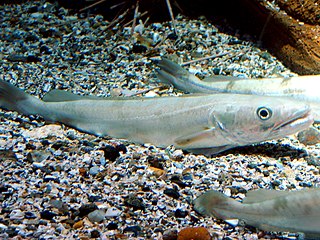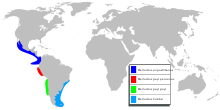
Hake is the common name for fish in the Merlucciidae family of the northern and southern oceans and the Phycidae family of the northern oceans. Hake is a commercially important fish in the same taxonomic order, Gadiformes, as cod and haddock.

The Merlucciidae, commonly called merluccid hakes, are a family of cod-like fish, including most hakes. They are native to cold water in the Atlantic and Pacific oceans, and typically are found at depths greater than 50 m (160 ft) in subtropical, temperate, sub-Arctic or sub-Antarctic regions.

Burmeister's porpoise is a species of porpoise endemic to the coast of South America. It was first described by Hermann Burmeister, for whom the species is named, in 1865.

The Humboldt Current, also called the Peru Current, is a cold, low-salinity ocean current that flows north along the western coast of South America. It is an eastern boundary current flowing in the direction of the equator, and extends 500–1,000 km (310–620 mi) offshore. The Humboldt Current is named after the German naturalist Alexander von Humboldt even though it was discovered by José de Acosta 250 years before Humboldt. In 1846, von Humboldt reported measurements of the cold-water current in his book Cosmos.

The Chilean skua, also called the cinnamon skua, is a large predatory seabird, which breeds in Argentina and Chile, but ranges as far north as Brazil and Peru when not breeding. A relatively distinctive skua, it has a dark cap that contrasts with its cinnamon throat and lower face. Hybrids with the Falkland skua are known from southern Argentina.

Thyrsites atun, known as the snoek in South Africa and as the barracouta in Australasia, is a long, thin species of snake mackerel found in the seas of the Southern Hemisphere, and a popular food fish in South Africa, particularly along the west and southwest coast. Despite its Australasian name, it is not closely related to the barracuda.

The North Pacific hake, Pacific hake, Pacific whiting, or jack salmon is a ray-finned fish in the genus Merluccius, found in the northeast Pacific Ocean from northern Vancouver Island to the northern part of the Gulf of California. It is a silver-gray fish with black speckling, growing to a length of 90 cm (3 ft). It is a migratory offshore fish and undergoes a daily vertical migration from the surface to the seabed at depths down to about 1,000 m (3,300 ft).

The silver hake, Atlantic hake, or New England hake is a merluccid hake of the genus Merluccius, found in the northwest Atlantic Ocean. It is highly predatory and typically feeds on fish and crustaceans.

Merluccius is a genus of merluccid hakes from the Atlantic and Pacific Oceans, where mainly found relatively deep.

Merluccius merluccius, the European hake, is a merluccid hake of the genus Merluccius. Other vernacular names include Cornish salmon and herring hake. It is a predatory species, which was often netted alongside one of its favoured prey, the Atlantic herring, hence the latter common name. It is found in the eastern Atlantic from Norway and Iceland south to Mauritania and into the Mediterranean Sea. It is an important species in European fisheries and is heavily exploited, with some populations being fished unsustainably.

Merluccius capensis is a ray-finned fish in the genus Merluccius, found in the south-eastern Atlantic Ocean, along the coast of South Africa. It is a long, lean fish with a large head, similar in appearance to the European hake and the deep-water Cape hake. By day, it lives close to the bottom on the continental shelf and upper slope at depths not usually exceeding 400 m (1,300 ft); it makes a large, daily vertical migration rising at night to feed in the nectonic zone, and it also migrates southwards in spring and northwards in autumn. It is an important commercial fish species in southern Africa.

The Argentine hake is a merluccid hake of the genus Merluccius, found in the southwestern Atlantic Ocean, along the coast of Argentina, and Uruguay. This fish was described by an Argentine ichthyologist, Tomás Marini in 1933.
Merluccius paradoxus, the deep-water Cape hake, is a merluccid hake of the genus Merluccius, found in the south-eastern Atlantic Ocean, along the coast of Southern Africa, south of Angola. Its range extends in decreasing abundance around the southern coast of Africa and into the Indian Ocean, but it is at its most plentiful in the cold, nutrient-rich fishing grounds of the Benguela Current.

The Chilean jack mackerel, sometimes called the Jurel, Inca scad or Peruvian jack mackerel, is a species of jack mackerel in the genus Trachurus of the family Carangidae. Since the 1970s, it has become one of the world's more important commercial fish species. High volumes have been harvested, but the fishery may now be in danger of collapsing.

The Cape horse mackerel is a mackerel-like species in the family Carangidae. It is a pelagic species of the south eastern Atlantic Ocean which is a target of fisheries, mainly as bycatch.
The Panama hake, also known as the dwarf hake, is a merluccid hake found off the west coast of the Americas from Del Mar, California, to Ensenada de Tumaco, Colombia.
Merluccius australis, the southern hake, is a species of fish from the family Merlucciidae, the true hakes. It is found in the southern Pacific and Atlantic Oceans with two disjunct populations, one around southern South America and the other in the waters around New Zealand.
Merluccius polli, the Benguela hake, is a species of fish from the family Merlucciidae, the true hakes. It is found in the tropical waters of the eastern Atlantic Ocean off the west coast of Africa.
Merluccius senegalensis, the Senegalese hake, is a species of fish from the family Merlucciidae, the true hakes. It is found in the sub tropical waters of the eastern Atlantic Ocean off the north western coast of Africa.

Stomias boa, also known as the boa dragonfish, scaly dragonfish, dragon-boa or boa scaly dragonfish, is a species of deep-sea fish in the family Stomiidae. It is found at great depths worldwide in tropical to temperate oceans but is absent from the northern Pacific and northwest Atlantic Oceans.
















